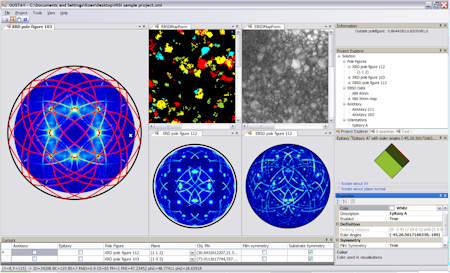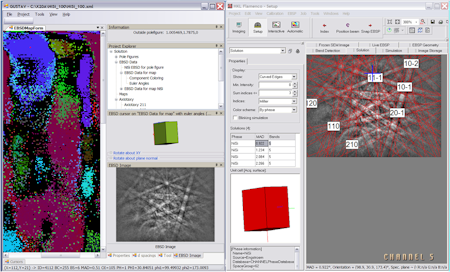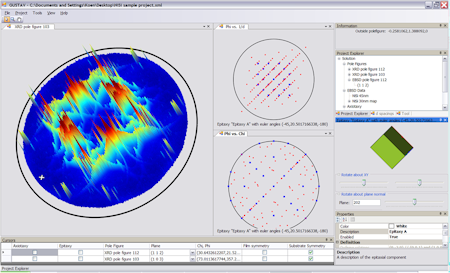Gustav
What is Gustav?
GUSTAV, short for Ghent University Software for Texture Analysis and Visualization is an in-house developed software package to analyze XRD pole figure data and EBSD data measured on thin films with a single crystal substrate. As its name already indicates, it has two main goals:
- Analysis of texture: starting from raw data (XRD, EBSD), extract a concise model of the texture
- Visualize the raw data, and the texture model in a modern, interactive way, using the possibilities provided by modern computers
Why a new tool for texture analysis?
The development of GUSTAV started from the observation that most software to do texture analysis is focused on bulk materials. In thin films, grown on single crystal substrates, the texture is predominantly characterized by a matching of planes or directions of the film crystal to the substrate crystal. Since the substrate is a single crystal, its symmetry elements will result in the occurrence of orientational variants in the film. By already incorporating this information in the program, the analysis becomes faster and easier. Our datasets also proved to be different from most other texture data: the texture is typically very sharply defined, requiring the need to use pole figures and ODF's with a grid size of 1 deg or less, options which are often not present in other software. In addition, materials have often a low-symmetry and multiple phases coexist in the films. Next, we found that the visualization capabilities of most texture software lags behind what is currently possible on modern computers. GUSTAV provides interactive 3D views of all of its data: pole figures, crystals, ODF and Rodriguez-Frank space. For this, it uses the GPU in the computer through Direct3D. This also enables large dataset to be visualized without the need of data-processing: ODF's with a grid of 1x1x1 can easily be shown, rotated in all direction in 3D, using a volumetric ray-tracing method running on the GPU. Building on this, we chose to make GUSTAV interactive. As new views or crystallographic objects are created, based on other objects or data, they become connected, and a change in the underlaying data or object will automatically propagate to all dependant objects or visualizations. This makes it possible to do a "what-if" analysis:
And finally, we opted to work with a texture model, instead of an ODF. Even though ODF calculation has now become a standard tool in texture analysis, its application to thin films with extremely sharp features proves problematic. For this reason, we represent the texture as a combination of texture components (i.e. epitaxy, axiotaxy, fiber), and calculate a simulation of the pole figures based on these components. This simulation is shown as an overlay on top of the measured pole figures, to allow for a direct comparison.
What can it do?
Currently, it has the following capabilities:
- Support of multi-phased films
- Loading and visualizing pole figures recorded with a point detector or a linear detector
- Identification of epitaxial orientation relations between film and substrate by combining information from multiple pole figures, automatically taking into account symmetry of film and substrate
- Identification of axiotaxy and fiber texture components
- Overlaying the simulations of both axiotaxy and epitaxy on the pole figures
- Displaying of the lattice in a specific orientation
- Visualizing the matching between an eptiaxial film crystal and the substrate, both in real space, and in projected (on the interface) reciprocal space
- Calculation of fundamental zones (for Rodriguez Frank space) for any crystal symmetry, and for any combination of crystal symmetries of film and substrate
- Interactive, high resolution visualization of ODF's and Rodriguez-Frank space
How does it work?
The curreny version of GUSTAV consists of a C++ calculation backend and a C# .NET interface, which uses Direct3D for the drawing of the pole figures, ODF and Rodriguez-Frank spaces. In addition, it is possible to communicate with the Oxford Instruments / HKL Channel 5 software, to index EBSP's.


